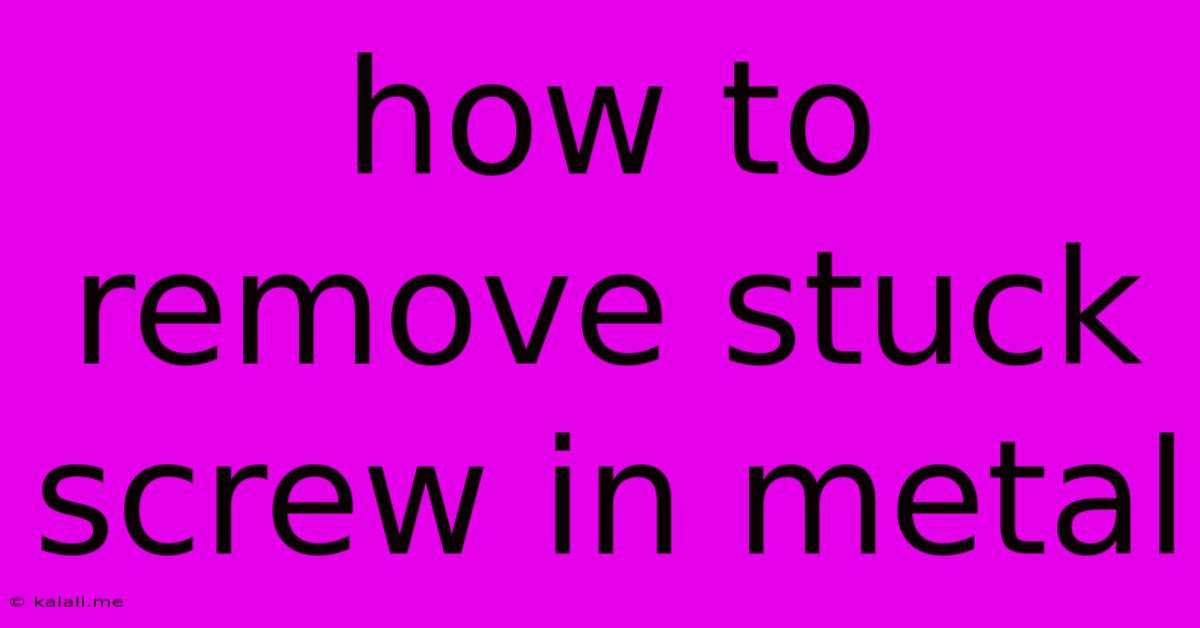How To Remove Stuck Screw In Metal
Kalali
Jun 04, 2025 · 3 min read

Table of Contents
How to Remove a Stuck Screw in Metal: A Comprehensive Guide
Removing a stuck screw from metal can be incredibly frustrating, but with the right techniques and tools, it's often achievable without causing significant damage. This comprehensive guide covers various methods, from simple solutions to more advanced techniques, ensuring you can tackle this common problem effectively. Whether it's a stripped screw, a rusted screw, or one simply stuck tight, we've got you covered.
Understanding Why Screws Get Stuck
Before diving into removal methods, let's understand why screws become stuck in the first place. Common culprits include:
- Corrosion: Rust and oxidation create a tight bond between the screw and the metal, making removal difficult.
- Over-tightening: Applying excessive force during installation can deform the screw head or the surrounding metal.
- Stripped screw heads: Damaged or stripped screw heads offer little grip for a screwdriver, leading to slippage and further damage.
- Thread locking compounds: These substances are designed to prevent screws from loosening, but can make removal challenging.
- Material deformation: The metal around the screw might have deformed during installation or due to stress, making removal difficult.
Methods for Removing Stuck Screws
The best approach depends on the severity of the issue and the type of screw. Here are several strategies, ranging from simple to more advanced:
1. The Basics: Penetrating Oil and Leverage
- Penetrating Oil: This is your first line of defense. Apply a generous amount of penetrating oil (like WD-40 or a similar product) to the screw head and surrounding area. Allow it to penetrate for at least 30 minutes, or even overnight for stubborn screws. This helps to break down rust and corrosion.
- Leverage: After the oil has had time to work, try using a screwdriver that fits snugly. Apply firm, steady pressure, and slowly try to turn the screw counterclockwise. If the head is damaged, consider using pliers or vise grips for better grip.
2. Heat Application:
Heat can expand the metal, potentially breaking the bond between the screw and the material. Use a heat gun or soldering iron carefully to warm the area around the screw. Be cautious not to overheat the metal, as this could damage the surrounding material. After heating, try using a screwdriver and penetrating oil.
3. Screw Extractors:
For stripped screws, screw extractors are invaluable. These specialized tools have reverse threads that bite into the screw, allowing for removal. Choose an extractor slightly smaller than the screw's diameter. Drill a pilot hole carefully into the center of the stripped screw head, then use the extractor to turn the screw counterclockwise.
4. Drilling Out the Screw:
As a last resort, you may need to drill out the screw. This requires precision and patience. Use a drill bit slightly smaller than the screw's shaft diameter, and drill carefully to avoid damaging the surrounding metal. Once the screw head is removed, use a center punch to mark the shaft and carefully drill it out.
5. Using a Rubber Band:
For slightly stripped screws, placing a rubber band over the screw head before inserting your screwdriver can provide extra grip and prevent slippage.
Prevention is Key
Preventing stuck screws is easier than removing them. Here are some proactive measures:
- Use the right size screwdriver: This prevents damage to the screw head and ensures a proper fit.
- Apply lubricant: Using a lubricant during installation can prevent future seizing.
- Avoid over-tightening: Tighten screws firmly, but avoid excessive force.
Removing stuck screws requires patience and the right approach. By carefully considering the severity of the issue and using the appropriate techniques, you can successfully remove those stubborn screws and avoid further damage to your metal work. Remember safety precautions when using power tools and heat.
Latest Posts
Latest Posts
-
Remove Types Of Files You Cans Earch For On Alfred
Jun 06, 2025
-
How Many Amps Does A Washer Use
Jun 06, 2025
-
Reliance 31410crk Transfer Switch Internal Wiring Diagram
Jun 06, 2025
-
A Group Of Scorpions Is Called
Jun 06, 2025
-
R Does The Biggest Cook Distance Point Outlier
Jun 06, 2025
Related Post
Thank you for visiting our website which covers about How To Remove Stuck Screw In Metal . We hope the information provided has been useful to you. Feel free to contact us if you have any questions or need further assistance. See you next time and don't miss to bookmark.